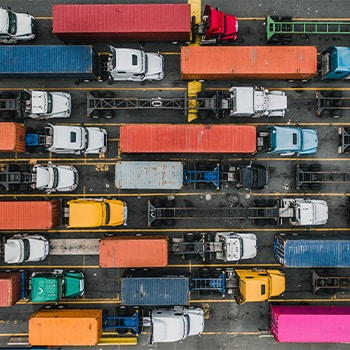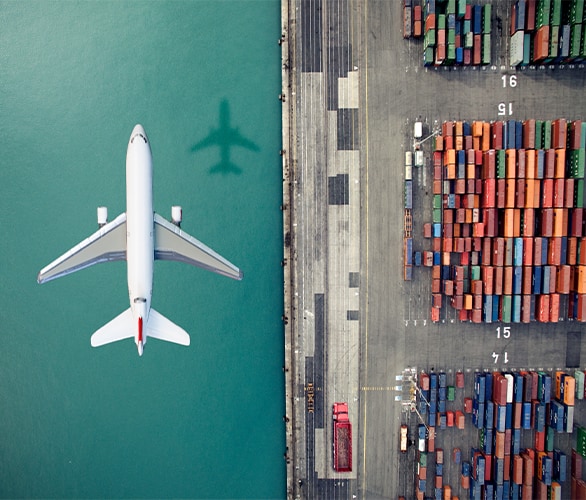The Drive to Decarbonize has been saved

Blog
The Drive to Decarbonize
The Future of Energy blog series
In a drive for a net-zero world, the decarbonization of the transport sector will be essential as it accounts for almost one-quarter of global emissions.
Authors: Maren Heumann, Sietse van de Riet
In a drive for a net-zero world, the decarbonization of the transport sector will be essential as it accounts for almost one-quarter of global emissions. The challenge will be particularly difficult in some of the harder-to-abate sectors such as shipping, road freight and aviation, accounting for 13% of global CO2 emissions. Structural factors like high energy dependency, relatively long asset lifespans, and complexity of electrification make decarbonization a complex challenge. How are we going to decarbonize the hardest-to-abate transportation sectors?
Decarbonising Shipping: All Hands on Deck
Shipping is considered to be the backbone of our economy, accounting for about 80% of the volume of global trade, but also 2% of global CO2 emissions. Never more so than during the Covid pandemic have we understood the importance of shipping to maintain the supply of essential goods. Shipping is a capital-intensive industry characterized by large, long-life assets, thin margins, and a high dependence on a global supply of energy-dense fuels. Conventional marine fuels come at low cost, considering they are literally the ‘bottom-of-the-barrel'. These characteristics make decarbonization complex and expensive.
The industry is currently exploring several alternative fuels – including hydrogen, ammonia, methanol, and biofuels – but shipping leaders have indicated that they all have commercial and technical limitations. LNG is considered as a transition fuel, though critics point out that LNG will be insufficient to meet decarbonization targets, carries the risk of methane emissions in the supply chain and distracts the industry from investments in zero-emission fuels. Hydrogen and ammonia have significantly lower energy density than conventional marine fuels, requiring either new technology, more frequent refueling stops, or compromised cargo space to store fuel. Methanol may also play a role as it offers simpler handling and lower investment cost and can be produced from renewable sources, such as biomass, and eventually synthetically with CO2.
There is a growing view that now is the time to act if the industry is to meet the set targets. To reach those, many shipping leaders believe that the first net-zero ships will need to start entering the global fleet by around 2030 – and that creates a real sense of urgency.
Decarbonising Road Freight: Getting into Gear
Road Freight is the most flexible mode of transport, and the primary mechanism to bring goods to our stores and homes. It is the largest of the transport sectors in terms of emissions, currently accounting for around 8% of global CO2 emissions, the majority of which comes from medium and heavy freight trucks. In order to achieve the goals of the Paris Agreement, absolute emissions from road freight will need to decline almost 60% by 2050, despite a possible doubling of road freight volume over the same period. Therefore, the sector will need to realize an emission intensity reduction of over 80% in less than 30 years. More pressingly, the sector’s emission intensity should decline by around 30% before 2030 – an unprecedented challenge.
The two viable low-emission or zero-emission technologies for Road Freight are battery electric vehicles (BEV) and hydrogen or fuel cell electric vehicles (FCEV), with different applications varying per duty cycle. BEV have an advantage on short or medium distances with enough breaks for charging and overnight idle time. Typical application areas already today are light commercial vehicles, often used for last-mile deliveries in urban areas, or milk runs deliveries to supermarkets. FCEVs are more viable on long distances with fewer breaks, which allows truckers to operate 24/7 and multi-day trips with heavy-duty vehicles.
Both technologies will start entering the global fleet at scale in the coming decade, with BEV expected to start in the mid-2020s and FCEV towards the end of the decade. Increasing regulatory and market pressure, such as low-emission city zones, are likely to accelerate the shift towards low- and zero-emission trucks.
Decarbonising Aviation: Cleared for Take-off
Aviation helps foster cultural exchange and provides global access to goods and services, but it is also a source of around 3% of global CO2 emissions. Due to continued global economic and population growth in the upcoming decades, aviation volume and emissions are expected to more than double by 2050. The global nature of aviation makes it a complex sector to regulate and there is no silver bullet to decarbonization. Nevertheless, roughly half of the industry players have committed to achieving net-zero emissions by 2050.
Sustainable aviation fuel (SAF) and carbon offsets are two available options to reduce emissions in the next 20-30 years. Bio-SAF from certain feedstocks is already mature, but production is relatively low (<0.1% of global fuel consumption). A major barrier is price, as bio-SAF is two times the cost of fossil fuel, and up to eight times if synthetic SAF is produced, which uses carbon capture or direct air capture in combination with green hydrogen. Carbon offsets can play an essential role in funding the early stages of decarbonization but need to be made more transparent and verifiable.
At the same time, the sector must work to continue improvements in aircraft and operational efficiency, and develop alternative propulsion technologies, such as batteries and hydrogen. These technologies offer an additional possibility of zero-emission flying, but changing to them will be much harder than switching from kerosene to a SAF drop-in solution due to higher weight or volume requirements.
Sector comparison
Structural differences explain why certain technologies are more or less likely to contribute to decarbonization per sector.
First, the incentives to decarbonize differ. The aviation business is highly consumer centric, which implies costs of transition is more likely to be absorbed by demand coalitions. Regulatory incentives are easier to be implemented in a few large ports in the Shipping sector, compared to the global nature of the Aviation sector, which makes it inherently difficult to regulate.
With regards to the feasibility of decarbonization, technology barriers are likely to play a large role in the shipping sector as there is no currently available alternative technology, whereas SAF provides a viable low-emission alternative to kerosene in the aviation sector if scaled. Clarity on roles and decision-making may form a barrier for the many fragmented owners in the Road Freight sector.
Lastly, the speed of decarbonization is impacted by the ease of asset and infrastructure replacements. Long-life assets in Shipping are difficult to change, and the same applies to Aviation if alternative propulsion technologies (in contrast to drop-in SAF) are needed. Infrastructure replacement will be a major challenge for the fragmented Road Freight market with many charging or fuelling stations required along the global highways.
Market demand, regulation, and legacy infrastructure are common barriers to decarbonization across industries

Conclusion
Societal pressure to reduce CO2 emissions from the hardest-to-abate sectors is mounting, and governments and companies all over the globe are starting to act on the goals set by the Paris Climate accord. Whilst some sectors are reaching their inflection point, others will need significant further effort and investments to become carbon neutral, especially taking into account some sectors are growing. Technology solutions have emerged and are mature enough for implementation but need substantial investment and scaling to reduce cost and build rapport in their respective sectors. As the hardest-to-abate sectors are accounting for 13% of global CO2 emissions, the road to full decarbonization will be a difficult one. However, as a society and the sectors themselves are now realizing, the time to act is now.
Future of Energy Insights
Would you like to stay up-to-date on the energy transition and be the first to receive our Future of Energy insights? Fill in the form below.
Recommendations
Will hydrogen be the surprise of this decade?
The potential of hydrogen will play an important role in the energy transition





